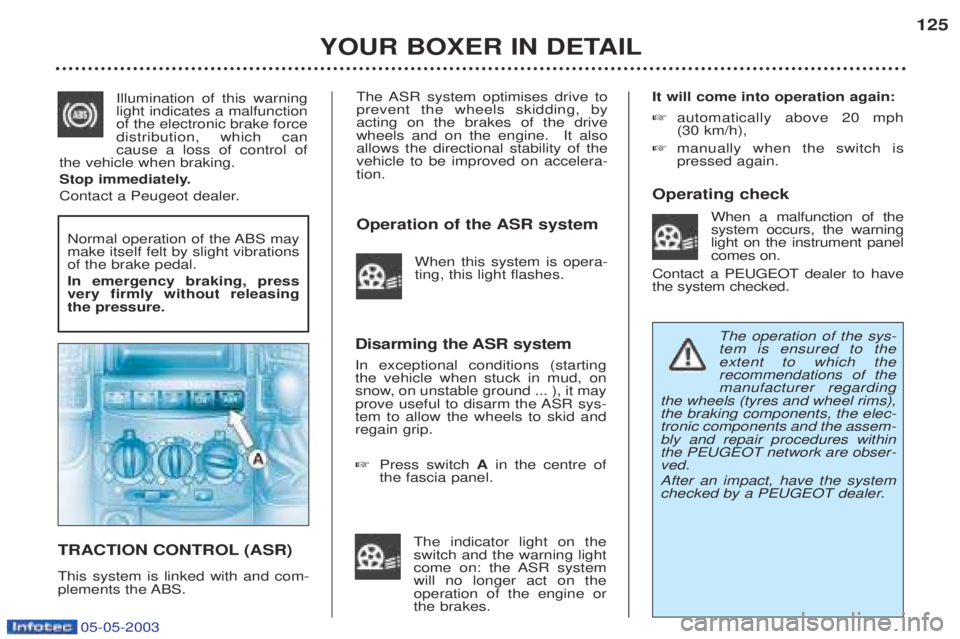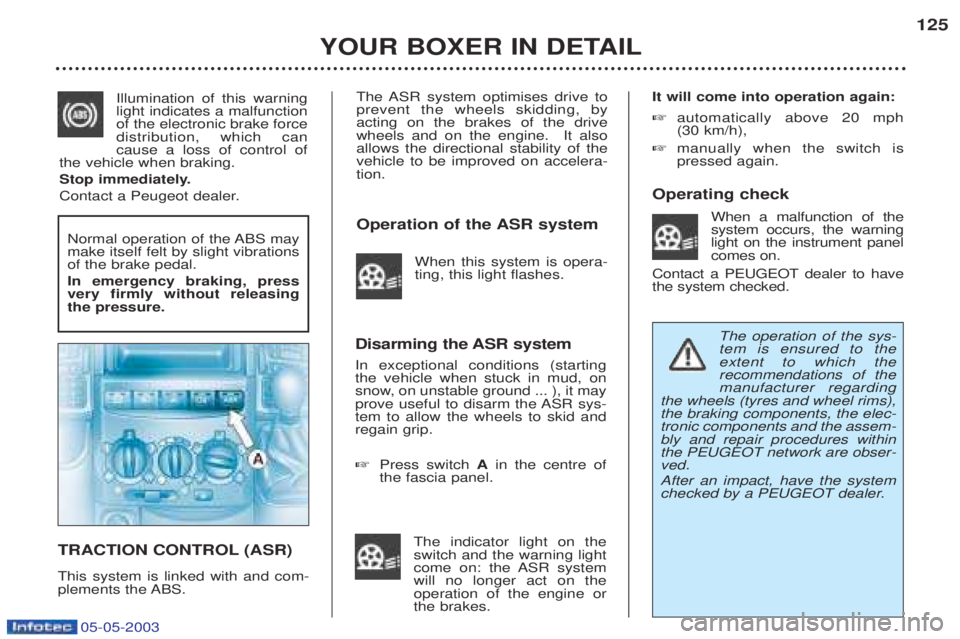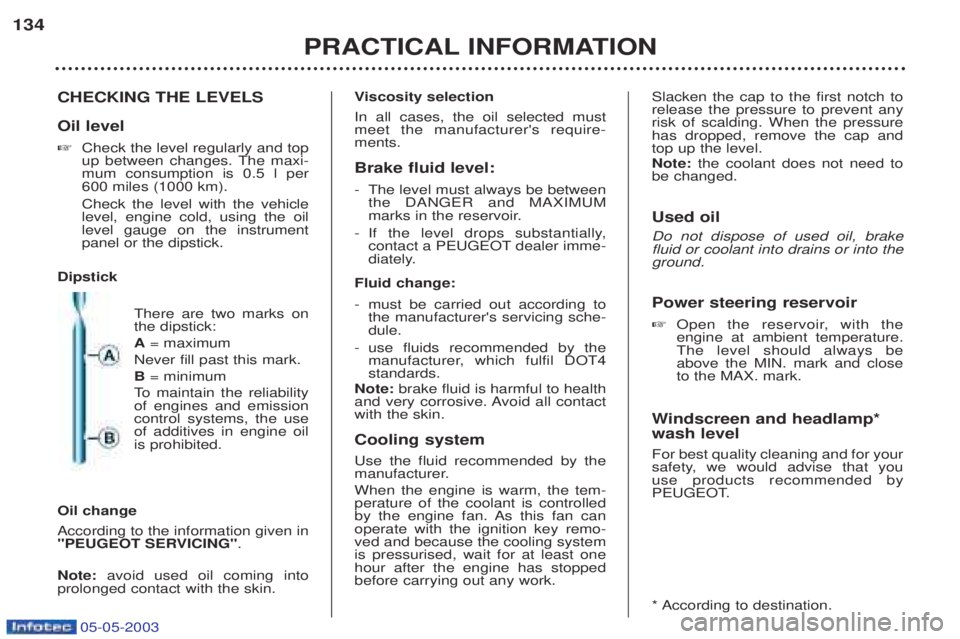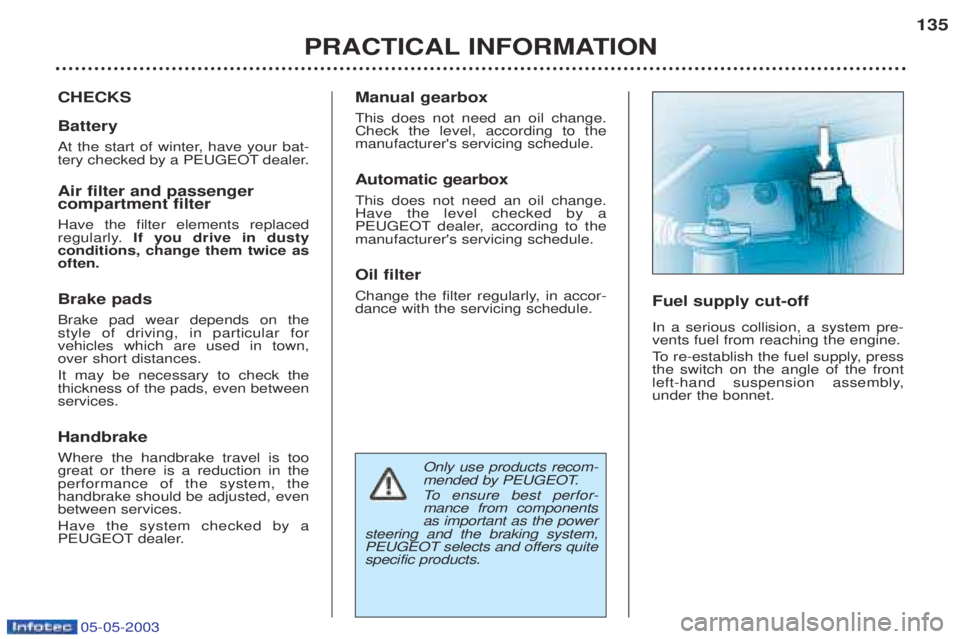Page 130 of 180

05-05-2003
The ASR system optimises drive to prevent the wheels skidding, byacting on the brakes of the drivewheels and on the engine. It alsoallows the directional stability of thevehicle to be improved on accelera-tion.
Operation of the ASR systemWhen this system is opera- ting, this light flashes.
TRACTION CONTROL (ASR) This system is linked with and com-
plements the ABS. Disarming the ASR system In exceptional conditions (starting the vehicle when stuck in mud, on
snow, on unstable ground ... ), it may
prove useful to disarm the ASR sys-tem to allow the wheels to skid andregain grip. ☞
Press switch Ain the centre of
the fascia panel.
The indicator light on the switch and the warning light
come on: the ASR systemwill no longer act on theoperation of the engine orthe brakes. It will come into operation again: ☞
automatically above 20 mph (30 km/h),
☞ manually when the switch ispressed again.
Operating check When a malfunction of thesystem occurs, the warninglight on the instrument panelcomes on.
Contact a PEUGEOT dealer to havethe system checked.
YOUR BOXER IN DETAIL 125
Normal operation of the ABS may make itself felt by slight vibrationsof the brake pedal. In emergency braking, press very firmly without releasingthe pressure.
The operation of the sys- tem is ensured to theextent to which therecommendations of themanufacturer regarding
the wheels (tyres and wheel rims),the braking components, the elec-tronic components and the assem-bly and repair procedures withinthe PEUGEOT network are obser-ved. After an impact, have the system
checked by a PEUGEOT dealer.
Illumination of this warning light indicates a malfunctionof the electronic brake forcedistribution, which cancause a loss of control of
the vehicle when braking.
Stop immediately.
Contact a Peugeot dealer.
Page 131 of 180

05-05-2003
The ASR system optimises drive to prevent the wheels skidding, byacting on the brakes of the drivewheels and on the engine. It alsoallows the directional stability of thevehicle to be improved on accelera-tion.
Operation of the ASR systemWhen this system is opera- ting, this light flashes.
TRACTION CONTROL (ASR) This system is linked with and com-
plements the ABS. Disarming the ASR system In exceptional conditions (starting the vehicle when stuck in mud, on
snow, on unstable ground ... ), it may
prove useful to disarm the ASR sys-tem to allow the wheels to skid andregain grip. ☞
Press switch Ain the centre of
the fascia panel.
The indicator light on the switch and the warning light
come on: the ASR systemwill no longer act on theoperation of the engine orthe brakes. It will come into operation again: ☞
automatically above 20 mph (30 km/h),
☞ manually when the switch ispressed again.
Operating check When a malfunction of thesystem occurs, the warninglight on the instrument panelcomes on.
Contact a PEUGEOT dealer to havethe system checked.
YOUR BOXER IN DETAIL 125
Normal operation of the ABS may make itself felt by slight vibrationsof the brake pedal. In emergency braking, press very firmly without releasingthe pressure.
The operation of the sys- tem is ensured to theextent to which therecommendations of themanufacturer regarding
the wheels (tyres and wheel rims),the braking components, the elec-tronic components and the assem-bly and repair procedures withinthe PEUGEOT network are obser-ved. After an impact, have the system
checked by a PEUGEOT dealer.
Illumination of this warning light indicates a malfunctionof the electronic brake forcedistribution, which cancause a loss of control of
the vehicle when braking.
Stop immediately.
Contact a Peugeot dealer.
Page 139 of 180
05-05-2003
PRACTICAL INFORMATION131
1 -
Power steering reservoir.
2 - Battery.
3 - Coolant reservoir. 4 -
Brake fluid reservoir.
5 - Air filter.
6 - Windscreen and headlamp wash
reservoir. 7 -
Fuse box.
8 - Engine oil filler cap.
9 - Dipstick.
2 LITRE PETROL INJECTION ENGINE
Page 140 of 180
05-05-2003
PRACTICAL INFORMATION
132
1 -
Power steering reservoir.
2 - Battery
3 - Coolant reservoir. 4 -
Brake fluid reservoir.
5 - Air filter.
6 - Windscreen and headlamp wash
reservoir. 7 -
Fuse box.
8 - Dipstick.
9 - Engine oil filler cap.
2.0 / 2.2 LITRE TURBO DIESEL HDI ENGINE
Page 141 of 180
05-05-2003
PRACTICAL INFORMATION133
1 -
Power steering reservoir.
2 - Battery.
3 - Coolant reservoir. 4 -
Brake fluid reservoir.
5 - Air filter.
6 - Windscreen and headlamp wash
reservoir. 7 -
Fuse box.
8 - Dipstick.
9 - Engine oil filler cap.
2.8 LITRE TURBO DIESEL HDI/TED ENGINE
Page 142 of 180

05-05-2003
PRACTICAL INFORMATION
134
CHECKING THE LEVELS Oil level ☞Check the level regularly and top
up between changes. The maxi-mum consumption is 0.5 l per600 miles (1000 km). Check the level with the vehicle level, engine cold, using the oillevel gauge on the instrumentpanel or the dipstick.
Dipstick
There are two marks onthe dipstick: A= maximum
Never fill past this mark.B = minimum
To maintain the reliability
of engines and emission control systems, the useof additives in engine oilis prohibited.
Oil change According to the information given in
"PEUGEOT SERVICING" .
Note: avoid used oil coming into
prolonged contact with the skin.
V iscosity selection
In all cases, the oil selected must meet the manufacturer's require-ments. Brake fluid level: - The level must always be between the DANGER and MAXIMUM
marks in the reservoir.
- If the level drops substantially,
contact a PEUGEOT dealer imme-
diately.
Fluid change: - must be carried out according to the manufacturer's servicing sche-dule.
- use fluids recommended by the
manufacturer, which fulfil DOT4standards.
Note: brake fluid is harmful to health
and very corrosive. Avoid all contactwith the skin. Cooling system Use the fluid recommended by the
manufacturer. When the engine is warm, the tem- perature of the coolant is controlled
by the engine fan. As this fan canoperate with the ignition key remo-ved and because the cooling systemis pressurised, wait for at least onehour after the engine has stoppedbefore carrying out any work. Slacken the cap to the first notch torelease the pressure to prevent anyrisk of scalding. When the pressurehas dropped, remove the cap andtop up the level. Note:
the coolant does not need to
be changed. Used oil Do not dispose of used oil, brake fluid or coolant into drains or into theground. Power steering reservoir ☞ Open the reservoir, with the engine at ambient temperature.The level should always beabove the MIN. mark and closeto the MAX. mark.
W indscreen and headlamp*
wash level For best quality cleaning and for your
safety, we would advise that you use products recommended by
PEUGEOT.
* According to destination.
Page 143 of 180

05-05-2003
Only use products recom-
mended by PEUGEOT.
To ensure best perfor-
mance from components as important as the power
steering and the braking system,PEUGEOT selects and offers quitespecific products.
CHECKS Battery
At the start of winter, have your bat-
tery checked by a PEUGEOT dealer. Air filter and passenger compartment filter Have the filter elements replaced
regularly. If you drive in dusty
conditions, change them twice asoften. Brake pads Brake pad wear depends on the style of driving, in particular forvehicles which are used in town,over short distances. It may be necessary to check the thickness of the pads, even betweenservices. Handbrake Where the handbrake travel is too great or there is a reduction in theperformance of the system, thehandbrake should be adjusted, evenbetween services. Have the system checked by a
PEUGEOT dealer. Manual gearbox This does not need an oil change. Check the level, according to themanufacturer's servicing schedule. Automatic gearbox This does not need an oil change. Have the level checked by a
PEUGEOT dealer, according to themanufacturer's servicing schedule. Oil filter
Change the filter regularly, in accor- dance with the servicing schedule.
Fuel supply cut-off In a serious collision, a system pre- vents fuel from reaching the engine.
To
re-establish the fuel supply, press
the switch on the angle of the front
left-hand suspension assembly,under the bonnet.
PRACTICAL INFORMATION 135
Page 149 of 180
05-05-2003
Removing and changing a fuse Before changing a fuse, you must establish the cause of the fault and have it cor-
rected. The fuse numbers are indicated on the fuse boxes. ☞Use the special pliers A.
Always change a faulty fuse for one of the same rating.
CHANGING A FUSE The fuse boxes are located in the lower part of the fascia (left and righthand side) and in the engine com-partment. The spare fuses and special pliers A
are fixed to the inside of the lids of the fascia panel fuse boxes. Fascia panel fuses ☞ Unscrew the bolts, then tilt the cover to access the fuses.
Correct
Incorrect
PRACTICAL INFORMATION 141
Pliers
A